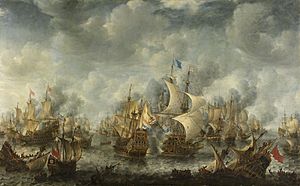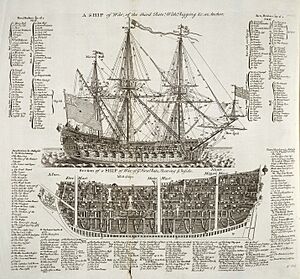Age of Sail facts for kids

The Age of Sail was a time in history when large sailing ships were super important. This period lasted from about the mid-1500s to the mid-1800s. During this time, sailing ships were the main way people traveled across oceans for trade and battles.
A big change during this age was the invention of cannons on ships. This made naval battles very different. The Age of Sail eventually ended when steam-powered ships became common. This era is part of the early modern period and the Age of Discovery, when explorers found new lands.
When Was the Age of Sail?
It's a bit tricky to say exactly when the Age of Sail started and ended. It's like trying to pinpoint the exact start of "modern times." The term means different things for warships and for ships that carried goods.
Cannons were used on ships in Europe as early as the 1300s. For example, they were used in the Battle of Arnemuiden in 1338. The 1400s saw brave sailors from Spain and Portugal explore the Atlantic Ocean. This was the start of the Age of Discovery.
For warships, the Age of Sail really began around the Battle of Lepanto in 1571. This was one of the last big battles where ships powered by oars, called galleys, played a major role. After this, sailing warships became the main type of battle ship. The age ended when steam-powered warships took over.
The Golden Age of Sail
The "Golden Age of Sail" happened a bit later, from the mid-1800s to the early 1900s. This was when sailing ships became their biggest and most complex. Think of fast clipper ships and huge windjammers. Even though steamships were appearing, these sailing giants were still amazing.
Why the Age of Sail Ended
The Age of Sail began to fade as new technology emerged: steam power.
The second steamboat to travel on the sea was the Experiment in 1813. It sailed from Leeds to Yarmouth in England. The first iron steamship to go to sea was the Aaron Manby in 1822. It crossed the English Channel and reached Paris, carrying people and goods.
Steam power soon changed warships too. The first battleship built specifically for steam power was the French ship Napoléon in 1850. Many steam battleships were used in the Crimean war. For example, they helped bombard Sevastopol.
Then came the ironclad ships. These were warships covered in thick iron plates for protection. The French Navy launched the first ironclad, Gloire, in 1859. In 1862, two ironclads, CSS Virginia and USS Monitor, fought each other in the Battle of Hampton Roads. This was a huge moment in naval history.
The opening of the Suez Canal in 1869 also sped up the end of the Age of Sail. This canal in the Middle East made the journey from Europe to Asia much shorter. Steamships could use it easily, but sailing ships found it harder. This made steamships even more useful.
By 1873, the Age of Sail for warships was mostly over. The British ship HMS Devastation, launched in 1871, was one of the first large battleships that didn't need sails at all.
Sailing ships still carried heavy goods for long trips into the 1920s and 1930s. They didn't need fuel or complex engines, which made them cheaper to run. However, steamships were faster and didn't depend on the wind. This meant steamships could deliver goods much quicker.
Because of this, sailing ships were used less and less for trade. Today, you mostly see sailing vessels for small-scale fishing, fun activities like yachting, or special passenger trips.
Recently, some shipping companies are looking at using wind power again. This is to save fuel and help the environment by reducing carbon emissions.
Legacy
Some experts believe a "New Age of Sail" might happen by 2030. This would be driven by new energy technology and the need to reduce pollution from ships. Books like Trade Winds: A Voyage to a Sustainable Future for Shipping explore this idea. They discuss how wind power could return to help shipping become more environmentally friendly.
See Also
- Age of Discovery
- Columbian Exchange
- Indian Ocean trade
- Maritime Silk Road
- Maritime timeline
- Naval history
- Sailing ship tactics
- Sea lane



